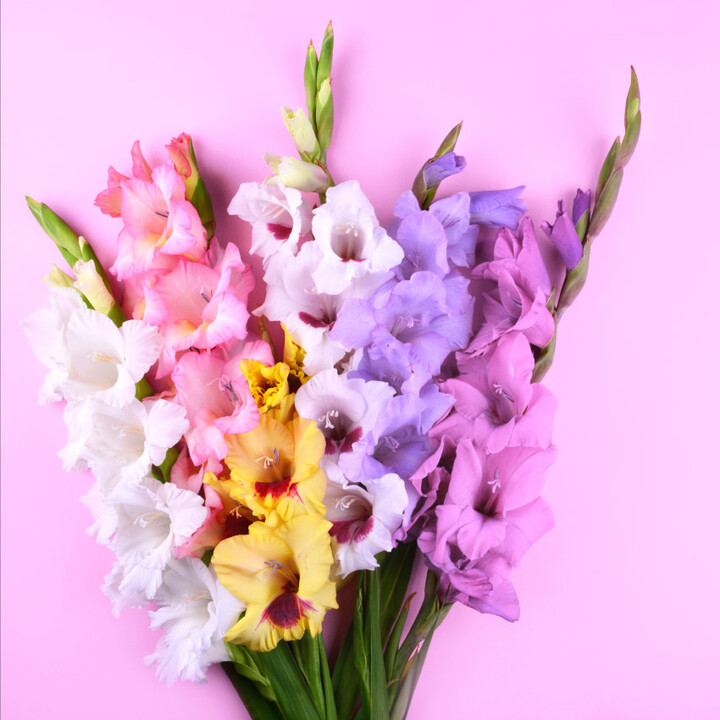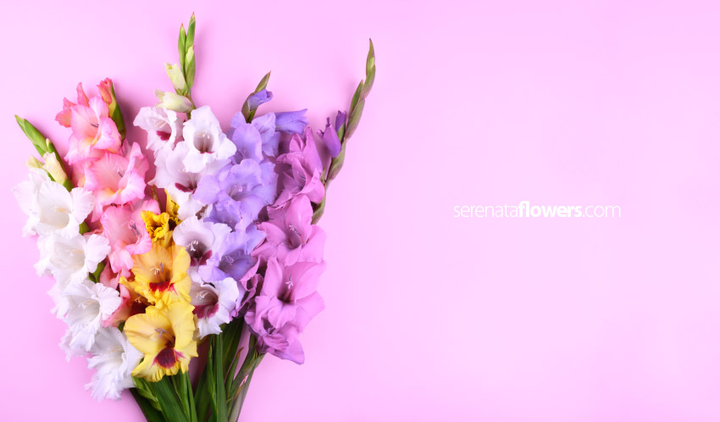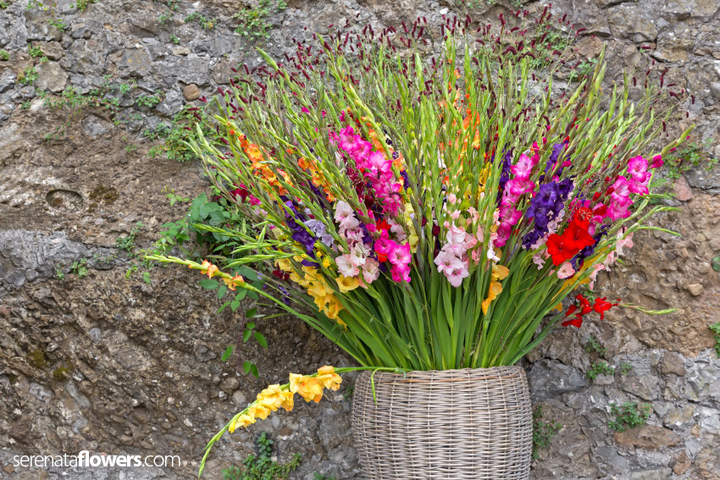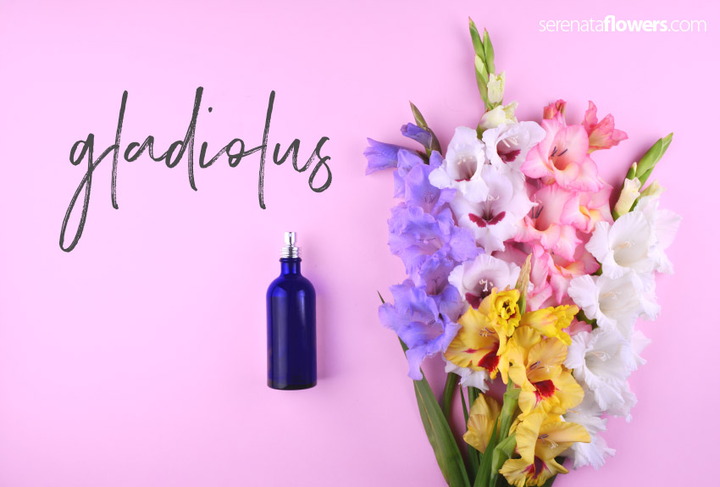
Gladiolus, often nicknamed the ‘Sword Lily’ because of its tall flower spikes, is a genus of perennial cormous plant from the iris family.
It’s native to tropical Africa, Asia, South Africa and Mediterranean Europe.
This particular specie can grow between two and six feet in height and boasts an array of hues.
Planting Gladiolus bulbs
Gladiolus bulbs should be planted once frost has passed, and when the soil has warmed.
This usually takes place in the spring but depends on climate and location.
·Begin by choosing a location – Gladioli prefer well-drained soil and full sun.
·Prepare your garden by using a garden fork to loosen the soil to about 12 to 15 inches deep, top with four inches of compost.
·Dig a hole measuring four inches deep and place the corm in the hole with the pointed end facing up. Top with soil and press firmly into the ground.
·If planting more than one corm, space three to six inches apart and water.
·When planting tall varieties, it’s important to stake them when planting, however you should be careful not to damage the corms.
· Once planted, it takes around 90 days for Gladioli to bloom.

Caring for Gladiolus plants
·In order to keep soil moist, add a layer of mulch to the soil. As well as keeping soil hydrated, this will also aid in preventing weeds.
·How many times you water gladioli per week depends on climate. For example, if you live in an area that gets less than an inch of water per week, water newly planted corms regularly.
·To promote continuous growth, remove the dead or faded flowers. If a stalk remains with no flowers, remove this too.
·Even when the plant ceases flowering, leave it intact as this will encourage new growth next season.
·If you live in a cooler climate, adding a layer of straw or hay to the soil will help to protect your plants in the winter months.
How to store Gladiolus bulbs over winter
So that you can enjoy Gladiolus flowers year after year, it’s a good idea to store bulbs during the winter months. Gladiolus corms tend not to be hardy throughout cooler weather. With this in mind, many gardeners will dig up bulbs before winter sets in and store them up until spring – this allows them to grow this species again the following year.
If you plan to do this, avoid digging up the bulbs too early, and instead, wait until the plant’s foliage has died. This is generally when the leaves start to turn brown.
To remove the bulbs from the ground, gently separate the surrounding soil using a garden spade or fork, without touching the corm. Once you have removed the soil, gradually wrench the plant from the soil by its dried leaves and shake gently to remove any loose dirt. Certain bulbs brandish miniature corms, which when cared for correctly, will flourish into full-sized plants in just a few years.
Once you’re ready to store the gladiolus bulbs, you must ‘cure’ them. You can do this by placing the bulbs on the surface of the soil for two days – this will allow them to fully dry out. Once dry, place them in a warm place with good air circulation and inside a cardboard box. The perfect temperature is 29°C.
The bulbs should be stored in this environment for around two weeks. Once completely dry, separate each bulb. Over time, Gladiolus bulbs will begin to form a new corm on top of the previous year’s bulb. The old bulb can be removed after drying. Once you have separated the new corms from the old corms and removed any foliage and excess dirt, place back in the cardboard box.

Growing Gladiolus in pots
If your garden has limited space, growing Gladiolus in pots is a great idea – provided you’re able to afford them the correct drainage conditions.
Firstly, choose a species – this may be a particular colour or height. Smaller plants tend to work better in pots.
However, if you decide to choose a larger variant, you will need use a stake. Choose a pot that measures 12 by 12 inches in diameter and cover the bulb with good quality potting soil. In order to ensure good drainage, it’s a wise idea to add a little gravel to the base of the container.
Gladiolus do not do well in waterlogged soil, as this will cause the bulb to rot. In order to ensure continuous blooms, plant Gladiolus bulbs at two-week intervals. Once planted, water the bulbs generously.
Caring for Gladiolus in containers
Water the plants regularly. New bulbs need more water than established plants. After the first watering, the roots and stems will begin to show. Once the flowers begin to bloom, you can either leave them in the container or cut them and place in a vase.
Gladiolus make great cut flowers and add instant colour to the home or office. If you decide to leave the flowers on the plant, simply remove the dead heads to encourage constant re-growth. When the flowers stop blooming, refrain from cutting away the foliage.
These leaves are able to continually produce food, which is stored in the bulb for the following year’s flower season.
Once the blooms have faded, it’s important to give the plant plenty of water. When the season is over, the leaves will turn a shade of brown and dry up.
Yellow leaves
Gladiolus plants often suffer from yellow foliage and this may be because of an unhealthy bulb, a viral disease or bacterial fungal. The most common reason however is Fusarium rot. This affects the bulb. Although these bulbs are able to produce foliage, any blooms will wither and fall off the plant. To prevent this, you will need to remove the affected bulbs from the beginning.
Gladiolus Varieties
Gladiolus plants come in a range of varieties, including red, white, yellow, pink, purple and orange hues. Each specie blooms at a different time of year and is of a different size, which means they’re a versatile option. They make great additions to the garden, especially to outdoor spaces in need of an injection of colour. They also attract a variety of wildlife, including hummingbirds.
Sizes
Gladiolus boast florets of various sizes, ranging from small to large petals, measuring from 2.5 inches to 5.5 inches. Those with florets smaller than 2.5 inches go by the name of miniature Gladiolus, while flowers with florets measuring 2.2 inches to 3.5 inches are called small Gladiolus. Florets measuring 3.5 inches to 4.5 are found on medium sized Gladiolus and florets measuring 4.2 inches to 5.5 inches are found on large Gladiolus.

Winter-Blooming Gladiolus
Winter-blooming Gladiolus originate from South Africa. These particular species are able to withstand light frost and include Gladiolus caeruleus, Gladiolus huttonii, Gladiolus carneus, Gladiolus miniatus, Gladiolus watsonius and Gladiolus teretifolius. In extremely cool climates, it’s important to plant gladiolus in the spring to bloom in the spring or summer.
Summer-Blooming Gladiolus
The majority of Gladiolus varieties bloom during summer. These varieties originate from Europe, South Africa and tropical parts of Africa. The European variants of summer-blooming gladiolus bloom well during summer in cooler climates. These include the likes of gladiolus muriale, gladiolus dalenii and gladiolus cruentes, as well as a number of gladiolus hybrids, such as gladiolus cruentus, gladiolus papilio and gladiolus oppositiflorus.